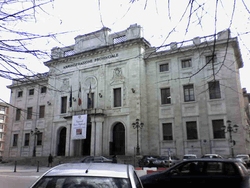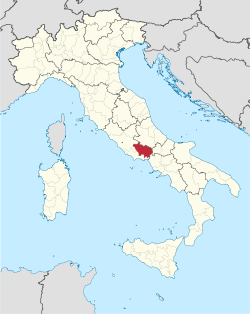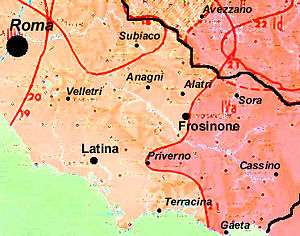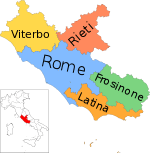Province of Frosinone
| Province of Frosinone Provincia di Frosinone | |
|---|---|
| Province | |
 Palazzo Gramsci in Frosinone, the provincial seat. | |
 Map highlighting the location of the province of Frosinone in Italy | |
| Country |
|
| Region |
|
| Capital(s) | Frosinone |
| Comuni | 91 |
| Government | |
| • President | Antonio Pompeo |
| Area | |
| • Total | 3,247.08 km2 (1,253.70 sq mi) |
| Population (30 June 2016) | |
| • Total | 493,605[1] |
| Time zone | UTC+1 (CET) |
| • Summer (DST) | UTC+2 (CEST) |
| Postal code | 03100 |
| Telephone prefix | 0775 |
| Vehicle registration | FR |
| ISTAT | 060 |
The Province of Frosinone (Italian: Provincia di Frosinone) is a province in the Lazio region of Italy, with 91 comuni (singular: comune; see Comuni of the Province of Frosinone). Its capital is the city of Frosinone. It has an area of 3,247 square kilometres (1,254 sq mi) and a total population of 493,605 (2016).
The Province was established by Royal Decree on 6 December 1926 with territories belonging to Lazio and to Campania. The Campania areas were the left valley of the Liri-Garigliano river, the district of Sora, the Comino Valley, the district of Cassino, the Gulf of Formia and Gaeta, the Pontine islands, which until then had been for centuries included in the Province called Terra di Lavoro, of the Kingdom of Naples (or of the Two Sicilies).
Main comuni
As of 31 December 2014,[2] the main comuni by population are:
History
The first traces of human presence in the provincial territory date back to prehistoric times: a famous skull of Homo erectus (Homo cepranensis, in the Prehistorical Museum of Pofi), dating from 800,000 years ago, constitutes the most ancient finding of the Homo species in Europe.
In historical times (10th-9th centuries BC), the area, previously occupied by the so-called Pelasgic civilization, was settled by Indo-European colonists. This arrival is referred to in numerous legends, such as those of Aeneas and Saturn. The latter, ousted by Olympus, was said to come to Lazio to help the men and found seven cities whose name begins with "A" (for example, Alatri and Anagni).

In the 7th century BC the area of what is now the province entered the orbit of Rome, which made it the so-called Latium adiectum ("Adjoined Lazio"). However, Rome needed some 300 years to obtain a definitive victory against the Volsci and the Hernici. They became Romanized after the Social and the Samnite Wars.
After the fall of the Western Roman Empire, the northern part of the province (officially referred to as Campagna since the 12th century[4]) belonged to the Papal States.
In the Middle Ages, the abbey of Monte Cassino was always a major landowner and a politically renowned element of the area. The southeastern part was a frontier area which was long claimed by the other major powers of the time, the Duchies of Benevento and Gaeta and the County of Aversa: annexed to the Kingdom of Naples under the Normans (12th century), from the late 14th century it became part of the county and then, with an independent status, of the Duchy of Sora. Pontecorvo remained a Papal enclave from 1463.
After the unification of Italy, in 1927 the Fascist government made Frosinone the capital of a province which unified different that which belonged to the Papal and Neapolitan states. This action generated criticism, as these states were considered too different in history, language and culture, especially by the Bourbon-nostalgic party that maintained a strong position in southern Italy for many decades.
The creation of a new province, with capitals in Cassino, Formia and Sora, and comprising the former territories of the Kingdom of Naples, has been proposed.
References
- ↑ http://demo.istat.it/bilmens2016gen/index.html
- ↑ Statistiche demografiche ISTAT Archived 2012-02-25 at the Wayback Machine.
- ↑ Pellegrini's map Archived 2009-10-12 at the Wayback Machine.
- ↑ Massimo Montanari, Storia medievale, Laterza, 2015
